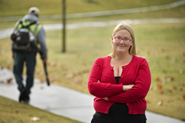19 January 2010
This press release has been updated to reflect the correction of a spreadsheet error in the scientific paper regarding carbon dioxide emissions during lawn maintenance. The correction, published 27 March, is available as stated in “Notes for Journalists” at the end of this release.
Challenging the notion that urban “green” spaces help counteract greenhouse gas emissions, new research has found — in Southern California at least — that mowing and other lawn maintenance emit almost as much or more greenhouse gases than the well-tended grass extracts from the air.

Amy Townsend-Small, UC Irvine
CREDIT: Steve Zylius, UC Irvine Communications
[ High-resolution image 11MB]
Previous studies have documented lawns storing carbon, but this research was the first to compare carbon sequestration to nitrous oxide and carbon dioxide emissions from lawn grooming practices.
“Lawns look great — they’re nice and green and healthy, and they’re photosynthesizing a lot of organic carbon. But the carbon-storing benefits of lawns can be counteracted by greenhouse gas emissions,” says Amy Townsend-Small, Earth system science postdoctoral researcher at University of California, Irvine. Townsend-Small is the lead author of the study, which has been accepted for publication in Geophysical Research Letters, a journal of the American Geophysical Union (AGU).
The research results are important to greenhouse gas legislation being negotiated, Townsend-Small says. “We need this kind of carbon accounting to help reduce global warming,” the lead author says. “The current trend is to count the carbon sinks and forget about the greenhouse gas emissions, but it clearly isn’t enough.”
Turfgrass is increasingly widespread in urban areas and covers 1.9 percent of land in the continental U.S., making it the most common irrigated crop.
In the study, Townsend-Small and colleague Claudia Czimczik analyze grass in four parks near Irvine, Calif. Each park contains two types of turf: ornamental lawns (picnic areas) that are largely undisturbed, and athletic fields (soccer and baseball) that are trampled a lot and replanted and aerated frequently.
The researchers took and evaluated soil samples over time to ascertain carbon storage, or sequestration, and they determined nitrous oxide emissions by sampling air above the turf. Then they calculated carbon dioxide emissions resulting from fuel consumption, irrigation and fertilizer production using information about lawn upkeep from park officials and contractors.
The study shows that nitrous oxide emissions from lawns are comparable to those found in agricultural farms, which are among the largest emitters of nitrous oxide globally.
In ornamental lawns, nitrous oxide emissions from fertilization offset just 10 percent to 30 percent of carbon sequestration. But fossil fuel consumption for management, the researchers calculate, releases about almost as much or more carbon dioxide than the plots can take up, depending on management intensity. Athletic fields fare even worse, because — due to soil disruption by tilling and resodding — they don’t trap nearly as much carbon as ornamental grass but require the same emissions-producing care.
“It’s unlikely for these lawns to act as net greenhouse gas sinks because too much energy is used to maintain them,” Townsend-Small concludes.
The UCI study was supported by the Kearney Foundation of Soil Science and the U.S. Department of Agriculture.
Joint Release
American Geophysical Union and University of California, Irvine
Cathy Lawhon, UC Irvine Contact, Phone: +1 (949) 824-1151, E-mail: [email protected]
Notes for Journalists
Journalists and public information officers (PIOs) of educational and scientific institutions who have registered with AGU can download a PDF copy of this correction.
The 22 January paper altered by the Correction can be downloaded.
Or, you may order copies of the Correction and/or the original paper by emailing your request to Peter Weiss at[email protected], or Cathy Lawhon at [email protected]. Please provide your name, the name of your publication, and your phone number.
Neither the Correction nor the original paper are under embargo.
News radio
UCI maintains on campus an ISDN line for conducting interviews with its faculty and experts. Use of this line is available for a fee to radio news programs/stations that wish to interview UCI faculty and experts. Use of the ISDN line is subject to availability and approval by the university.
“Carbon sequestration and greenhouse gas emissions in urban tur”
Amy Townsend-Small and Claudia I. Czimczik: Department of Earth System Science, University of California, Irvine, Calif., USA.
Amy Townsend-Small, UC Irvine scientist. Tel: +1 949-824-5755 or 6446, email: [email protected]